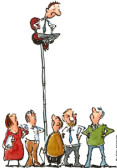| BACK | god & religion Summary | god & religion Full | Mentomatics | Reader Comments | My Beliefs on Religion | Godly Zones |
| Read Comments Submit Comments |
| In the Wonderland of Information Technology |
| by Prem Kamble |
CIO Balancing Act and the Great IT Circus
The CIO operates in a scenario where the customer expectations are very high. What makes the scenario worse is that these sky-high expectations are a result of some basic misconceptions about technology - the strong beliefs that computer is a super machine and is capable of doing wonders. The misconceptions are a legacy of the Industrial age. They are a result of the psychology of change from the industrial era to the information era. Obviously, when machines of industrial age have done such wonders in the area of automation, computer (the super machine) should do magic. I will not go into details of these misconceptions and the psychology of change as they are discussed in details elsewhere. (Click here to read.) Contrary to these common beliefs, the CIO manages one of the dumbest, most adamant animals in this great circus called business. That dumb animal is called the computer. The problem is compounded because this dumb and adamant beast also happens to be the most powerful animal. Whereas the customers think that he has a magic wand under his hood which can give instant and fabulous results, the poor CIO is actually messing around with one of the most difficult and in fact even inferior device. "Inferior?", you may ask. Yes, inferior if you deeply analyse this information age device with respect to the industrial age devices. Read What Top Executives Need to Know of Computers for details and for a comprehensive comparison of the machine age devices with computer. Sitting on a VolcanoThe CIO is harbouring one of the most difficult animals. He is in fact sitting on a volcano - because there can be a disaster with the slightest of errors. So, while most of his effort goes into managing, taming and learning about this beast, his actions are thought to be over cautious, at times too rigid. His customers keep wondering why he behaves the way he does when he has a magic wand, but the CIO alone knows how he manages the beast. This causes severe challenges for both the CIOs and the other managers resulting in stress, misunderstandings and conflicts. The result is stress for the CEOs to manage this conflict between his managers. This problem is not limited to underdeveloped or developing countries. It does not have to do with the technological backwardness of countries who have started late with automation. In the late 1980's when I was exposed to only the Indian computing scenario, I thought there was lack of IT awareness in Indian companies and Indian managers (and, maybe, other developing countries) because the developing countries had started off in the IT game much later than the developed nations (see Indian Computing: Issues at Stake, my article in Computers Today, Aug 1989 issue). Later when I worked in export oriented software companies and was exposed to global clients, I realized that the awareness problem was not for India and developing nations alone. The scenario was the same in the developed and advanced countries too. It was then that I realized that the lack of IT awareness is a global human phenomenon. It is a mindset issue and has nothing to do with technological advancement of countries or the lack of it. It relates to the psychology of evolution of human beings. (My article What Top Executives Need to Know of Computers explains how it is an evolution issue) The evolution of mankind from industrial age to the information age has led to some misconceptions. There is a need to understand the misconceptions, the reasons for the misconceptions, challenges for all managers, the ethical and unethical practices as a result of these misconceptions, skill gaps for CIOs, CEOs and other top managers, the losses due to this, the key success factors given the situation and the real possible solution to this imbroglio. There is also a need to understand the impact of this human problem on all aspects of a CIO role, including his relation with users, his own employees, the impact of this on the IT professionals jobs and their work environment. There is a need to look at the practices (good and bad) and to find a solution to the existing stressed scenario. Related Readings: Manager's Guide to Evolve from Machine Age to Information Age What Top Executives Need to Know About Computers More Articles for CIOs / IT Managers Also See: |
comments powered by Disqus